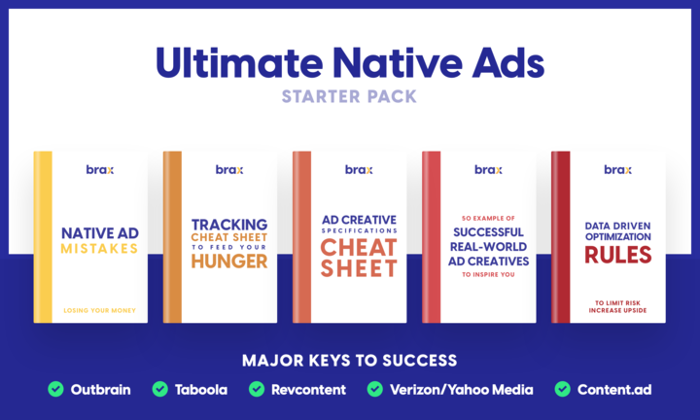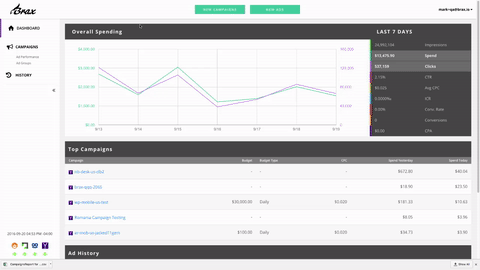Data about native advertising is clear. People trust and engage with native advertising more than with traditional display ads, and the numbers are going to keep on increasing with a $52.75 billion expected to be spent on native ads in 2020.
If you are looking to reach people more effectively with ads, you need to utilize native ads, and you need to have a native advertising strategy. Here's how:

In this guide, we are going over the essentials that you need to incorporate in your native advertising strategy to make native ads as effective as possible.
What Makes a Great Native Advertising Strategy
When thinking about your native advertising strategy, here are some of the key points that need to be considered:
- Your goals (Are you looking to increase brand awareness, generate leads, or get more sales?)
- Your audience
- The content that will help you meet your goals
- The type of content that will help you meet your goals
- What platform will your ads be on & budget
1. Setting Your Goals
When starting with a native advertising strategy, you need to figure out what your exact goals are with native advertising.
Without concrete goals, your results won’t be consistent.
Here are some examples of goals that people tend to have in their native advertising strategy:
- Increasing sales.
- Generations of Leads.
- Increasing traffic.
- Sign-ups for e-books.
- Acquiring newsletter subscribers.
- Increased brand awareness
Whatever your goals are, make sure to get specific. Stating that you want more newsletter subscribers is not enough.
How many do you want? And when do you want them?
When setting your goals, it’s also important to allocate how much you will spend, your ideal CPC (cost per click), and your spending limit.
2. Create a Target Audience for your Native Ads
Having a target audience is going to allow you to understand aspects such as how you need to speak to a client, what they expect from you, look for, what they value, and their issues, allowing you to create the most effective native ads for your company.
If you haven’t already, it might be worth looking into creating something called a Target Audience Profile, where you create a fictional character or a few of them that resemble what your target client might be like.

What’s the client’s personality like, what’s their age, where are they from, what are their issues?
Here are some things you for sure need to consider when establishing your target audience in your native advertising strategy:
- Needs.
- Problems.
- Buying motivations.
- Concerns.
- Age.
- Job.
- Personality.
- What they value.
3. Analyze native Ads
Once again, put yourself in the shoes of your target customer.
It’s very important not to think like an advertiser but as a reader or rather your target customer.
That type of content? It’s generally content that’s relevant, informative, and of course, filled with value.
The best way to learn native ads that work is by analyzing the ones that catch your eye as you are browsing the internet.
...Or perhaps read out native ads starter pack e-book in which we cover the major keys to success in native advertising.
4. Choose the Platform and Publishing Site
There are many different platforms that can be used for advertising such as Taboola, Outbrain, Yahoo Gemini, and others.
Which one is the best for native ads? It depends on your needs, but this is perhaps where Brax comes in as a tool that allows you to manage Native ad spending from all the main platforms in one place.
Regardless of what platform or platforms you end up using, choosing the right publishing sites is crucial for your native ads strategy.
When choosing what sites your native ads will be displayed on, you need to account for 3 essential factors, with those being:
- Relevance
- Demographics
- Audience Size
If you sell a product only in the US, it makes no sense for you to advertise on European sites. Just like it doesn't make sense for you to have native ads about fitness on tech sites.
5. Creating Your Native Ads
After you have your goals set, a target audience created, and know what kind of content you need to create, it's time to start creating native ads.
This is where the images and titles you use are key, as those two aspects, if done right on the right site, will result in clicks. Lots of click.
Brax has a built-in native ads builder that you can use for creating many variations of ads in just a few clicks. This will save you hours of time, especially if you are testing on multiple platforms.
6. Track and tweak
A great native ad strategy that works doesn't consist of doing everything right, right away.
It consists of experimenting and adjusting.
You aren't going to get your native ads optimized to their full potential right away.
And even when you do have a native ad strategy that is working, it won't always work the same. Not all ads will work the same on all sites, and not all ads will continue working in the long-term.
If you experiment with ads, you will have an always working native ad strategy.
That's the 6 key pieces to a great native ad strategy for 2020
Native ads are far more effective than display ads going into 2020, and if you want them to work for you, you need a native ad strategy.
To sum up:
- Set your goals.
- Create a target audience.
- Analyze your native ads
- Choose the ad platform and right publishing sites.
- Create your native ads.
- Tweak.
When you are looking to really scale beyond $10,000 a month, use www.brax.io to automate, optimize and analyse your campaigns quickly and effortlessly.



